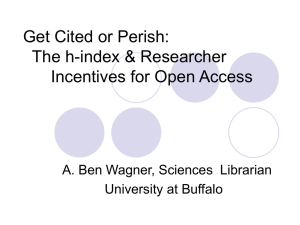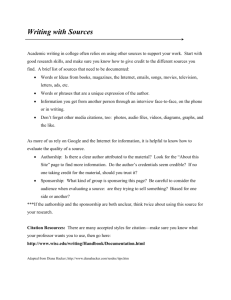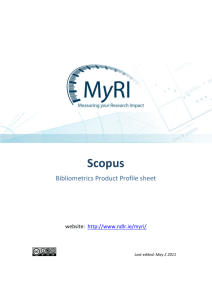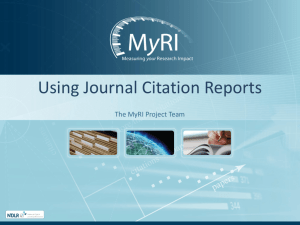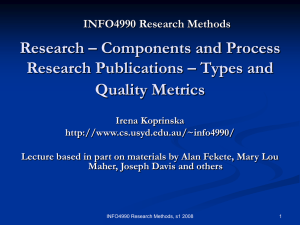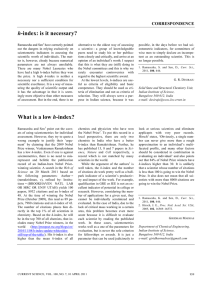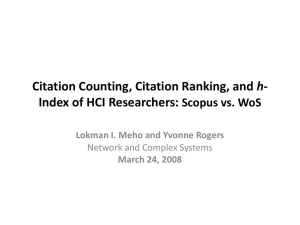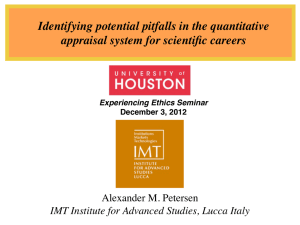Scientific Publications
advertisement
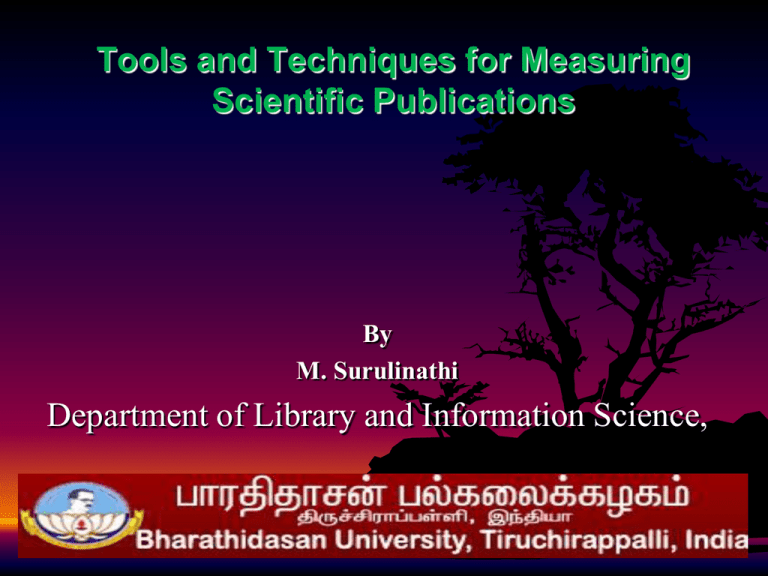
Tools and Techniques for Measuring Scientific Publications By M. Surulinathi Department of Library and Information Science, INTRODUCTION • Evaluating scientific quality is a notoriously difficult problem which has no standard solution. • Methods for evaluating research are being sought, such as citation rates and journal impact factors, h-index, g-index, Citation Scores etc., H-index • The h-index was developed by J.E. Hirsch and published in Proceedings of the National Academy of Sciences of the United States of America 102 (46): 16569-16572 November 15 2005. • Calculating the h-index Value - The h-index factor is based on the depth of your Web of Science subscription and your selected time span. Items that do not appear on the Results page will not be factored into the calculation. If your subscription depth is 10 years, then the h-index value is based on this depth even though a particular author may have published articles more than 10 years ago. Moreover, the calculation only includes items in Web of Science - books and articles in noncovered journals are not included. H-index H-graph G-index • The g-index is an index for quantifying the scientific productivity of physicists and other scientists based on their publication record. • It was suggested in 2006 by Leo Egghe. The index is calculated based on the distribution of citations received by a given researcher's publications. • Given a set of articles ranked in decreasing order of the number of citations that they received, the g-index is the (unique) largest number such that the top g articles received (together) at least g2 citations. g-index Citation Map • A Citation Map is a graphical representation that shows the citation relationships (cited references and citing articles) between a paper and other papers using various visualization tools and techniques. Using citation mapping, can analyze which researchers are citing your papers and also choose to organize and color code the results by author, year, journal title, subject category, and more. 1 Generation 2 Generations Global and Local Citation Scores Lotka’s Laws Bradford's Law Zipf's Law Journal Impact Factor Sources for Data Collection • The following Bibliographic Database will helps to collect the data for Scientometric and Bibliometric Study. • • • • • Web of Science Scopus PubMed Engineering Village2 LISA and LISTA etc., Webometrics Tools • Webometrics is (a) a set of quantitative techniques for tracking and evaluating the impact of web sites and online ideas and • (b) the information science research field that developed these ideas. Webometric techniques include link analysis, web mention analysis, blog analysis and search engine evaluation, but from the perspective of digital library evaluation the main method is link analysis. Webometrics Tools • Hit Counter • Alexa • Web Optimization • Google Analytics Hit Counter Web Optimization Source for Find the Publications • • • • • • • Google Scholar Web of Science Scopus Engineeringvillage2 Pubmed LISA LISTA and so on. Web of Science Database Scopus Database Engineeringvillage2 Pubmed Database Packages for Data Extraction • HistCite is a flexible software solution to aid researchers in visualizing the results of literature searches in the Web of Science. • • • • • • GCS - Global Citation Score shows the total number of citations to a paper in the Web of Science. LCR - Local Cited References shows the number of citations in a paper's reference list to other papers within the collection. LCS - Local Citation Score shows the count of citations to a paper within the collection NCR - Number of Cited References shows the number of cited references in the paper's bibliography. Recs - Number of Records shows the number of records where a given item is found. T* - Total [score] Any Total score represents a sum of respected scores for all records from a given author, source, other category, or all records Histcite for Mapping Bibexcel Open Source Software For Mapping Statistical Packages • SPSS • Systat Software Conclusion • Scientometric Study is one of the solutions for measuring the scientific Publications. • Once the Library Professional must familiar with the above tools and techniques and make use for measuring the Instructional Publications. • This Presentation will helps to aware and know the few measuring tools References • http://www.ischool.utexas.edu/~palmquis/courses/bibl io.html • http://0images.isiknowledge.com.impulse.ucdenver.edu/WO KRS410B4/help/WOS/h_citationrpt.html#h_citationrpt • http://0-adminapps.isiknowledge.com.impulse.ucdenver.edu/JCR/J CR?SID=3A4LG7G6CpID82iceJ3 • http://isiknowledge.com • http://www.spss.co.in/ • http://www.bmj.com/content/314/7079/497.1.extract
